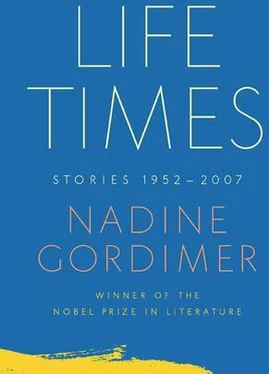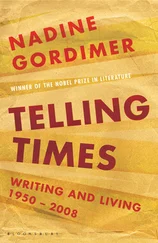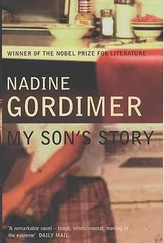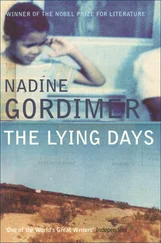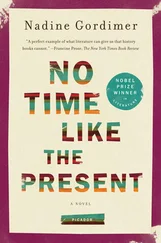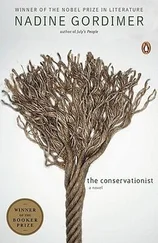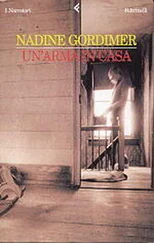It has been identified as a young, full-grown, male Chacma baboon. Only a baboon, after all; not an orang-outan, not a chimpanzee — just a native species.
The Kleynhans Place has now been photographed by newspapermen for papers published in English, Afrikaans and Zulu for specific readerships, black, white and in-between, and for the international press. It has acquired a capital ‘P’ to distinguish its ominous status as a proper noun, the name of a threat within the midst of the community of law and order. If the Kleynhans Place can exist, undetected, a farming plot like any other on the books of Klopper’s Eiendoms Beperk, what is left of the old, secure life?
Investigating the Kleynhans Place attack the police found two mattresses on the floor in the house, as well as two beds; old newspapers going back many weeks to that story about a monkey seen by some kids while they were swimming. Nothing there to work on. The only thing the white couple seemed to have forgotten was a home-made musical instrument, a sort of saxophone. (That was not ranged along with the exhibit of arms in the photograph released by the Security Chief to the press.) The Security Branch has searched its files for a political suspect known to have been a former musician. It is obvious the instrument was made by a black — a certain naive ingenuity, the kind of thing blacks manage to put together out of bits of junk in a mine compound or while serving long prison sentences. Contact with the Prisons Department in charge of Robben Island has brought the information that similar objects are sometimes made by the long-term politicals held there. This particular piece of work incorporated tin rings from beer cans (plenty of those found in the kitchen) and cartridges that match those in the cache of live ammunition.
Quite early on in their investigations the police released the information that one of the four people — two whites and two blacks — it has been established were responsible for the Kleynhans Place attack, was apprehended on the Swaziland border and killed in a shoot-out with the police. No policeman was injured in this incident. A guard at the power station lost two fingers but no other personnel were injured by the explosion, and there was no loss of life among personnel or public. The old man who had visited the Kleynhans Place to watch the progress of his mealie patch was brought to the police mortuary to look at the corpse of the dead black man. The face was in a state to be recognised although there wasn’t much left of the body. He identified the face as that of one of the farm boys who had worked for the white missus he had seen on the Kleynhans Place; this old man was therefore the key link in the investigation, proving beyond doubt that the white couple had set up house for the purpose of providing cover and a safe place for all four to plan the attack, and to store the weapons and ammunition required. (Mr Naas Klopper has testified that an open shed had been audaciously turned into a magazine with a steel door.) The two black men posed as farm labourers until a few days before the attack, when they moved to an old, abandoned mine-working near the power station. Blankets, the remains of fast-food packets, marked their occupation out there in the veld.
Nobody knows who the saboteurs, alive or dead, really are. There are names, yes — as the investigation has proceeded, as the interrogations at John Vorster yield results, there have been names. On the wrist of the dead man there was a cheap chain bracelet with a small plaque, engraved ‘Gende’, and it has been established that this was one of the names of a man known as ‘Eddie’, ‘Maxwell’ or ‘David Koza’. He had been among thousands detained in the riots of ‘76, as a schoolboy. He had left the country uncounted, when released; no one knew when he had gone and no one knows when he came back.
The white pair were not married. There is no such couple as Mr and Mrs Charles Rosser, who sat there shyly in Mrs Naas’s lovely home. The Afrikaans first name, ‘Anna’, was not the girl’s name. A Mr and Mrs Watson, living quietly in Port Elizabeth, who haven’t seen her for years — she changed ‘out of all recognition’ through political views they couldn’t tolerate — named her twenty-nine years ago ‘for joy’ at the birth of a little daughter. So far as they are aware she has never been to Australia. ‘Charles’ was christened Winston Derocher — one of those sentimental slips these politicals make, eh, coming as close as to call himself ‘Rosser’, when he must have known informants in England would supply John Vorster with a file on him!
The second black man, the survivor, has been identified as Zachariah Makakune, also know as Sidney Tluli. He is believed to have infiltrated from exile several times, and to have been responsible for other acts of sabotage, none of which involved loss of life, before the Kleynhans Place attack. But his luck must run out some day; he will kill or be killed. It was hoped that he had died in one of the South African Defence Force’s attacks over the borders on African National Congress men given asylum in neighbouring countries, but it was discovered that the Defence Force was misinformed; he had moved house, and it was new tenants, a building worker and his family, citizens of that country who had never been beyond its borders, who had been machine-gunned in their beds in his place.
So nobody really knows who he was, the one who died after the Kleynhans Place attack, nor whom they believed themselves to be, the three who survived and disappeared. Nobody really knows which names mark the identity each has accepted within himself. And even this is not known fully to himself: all that brought him to this pass; this place, this time, this identity he feels. ‘Charles’, sometime lover of Joy, ‘Charlie’, brother of ‘Vusi’ and ‘Eddie’ — Winston Derocher, given his father’s hero’s name as first name, does not know that his distant French ancestor, de Rocher, founding a family too confused by the linguistic and cultural exchanges of treks and intermarriage to keep records, was a missionary who, like himself, lived by assertion of brotherhood — another kind — outside the narrow community of his skin. ‘Vusi’ does not know that the rotgut liquor bottle he found with the trade name Hatherley Distillery came from Die Eerste Fabriek , approved by President Paul Kruger, the prototype factory on the veld where ‘Vusi’s’ own great-grandfather worked for the little money that was to become the customary level of wages for blacks, when the mining camp was proclaimed a town, a city, a great industrial complex.
Dr Grahame Fraser-Smith, looking back in fancy into the eyes of hominid evolution on a golf course, was ignorant of a more recent stage that had gone into his making. He doesn’t know he is descended, only three human generations back, from a housemaid, Maisie McCulloch, who was imported by a mining magnate to empty the slops in a late Victorian colonial mansion now declared a national monument, and who left this position to be taken over by blacks, herself opening a brothel for all races in Jeppe Street.
No one has ever found out who let the baboon loose.
The sacred member of the ape family, the work of art in the municipal art gallery, has both a known and a hidden provenance. It is authenticated as an eighteenth-century European copy of a seventh-century statue from Māllapuram, India. The old lady who donated it had migrated to South Africa to escape racial persecution in Europe. She was not aware of the rarity of her gift, and thought she was making a display of generous patronage of the arts without sacrificing anything valuable in the private cache of European culture she had saved, along with her own life, from destruction.
The mine-working where Eddie and Vusi hid, that Charles identified as belonging to the turn of the nineteenth century, is in fact far, far older. It goes back further than anything in conventional or alternative history, or even oral tradition, back to the human presences who people anthropology and archaeology, to the hands that shaped the objects or fired the charcoal which may be subjected to carbon tests. No one knows that with the brief occupation of Vusi and Eddie, and the terrible tools that were all they had to work with, a circle was closed; because before the gold-rush prospectors of the 1890s, centuries before time was measured, here, in such units, there was an ancient mine-working out there, and metals precious to men were discovered, dug and smelted, for themselves, by black men.
Читать дальше
